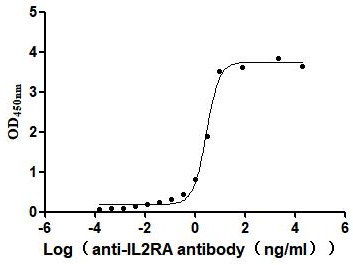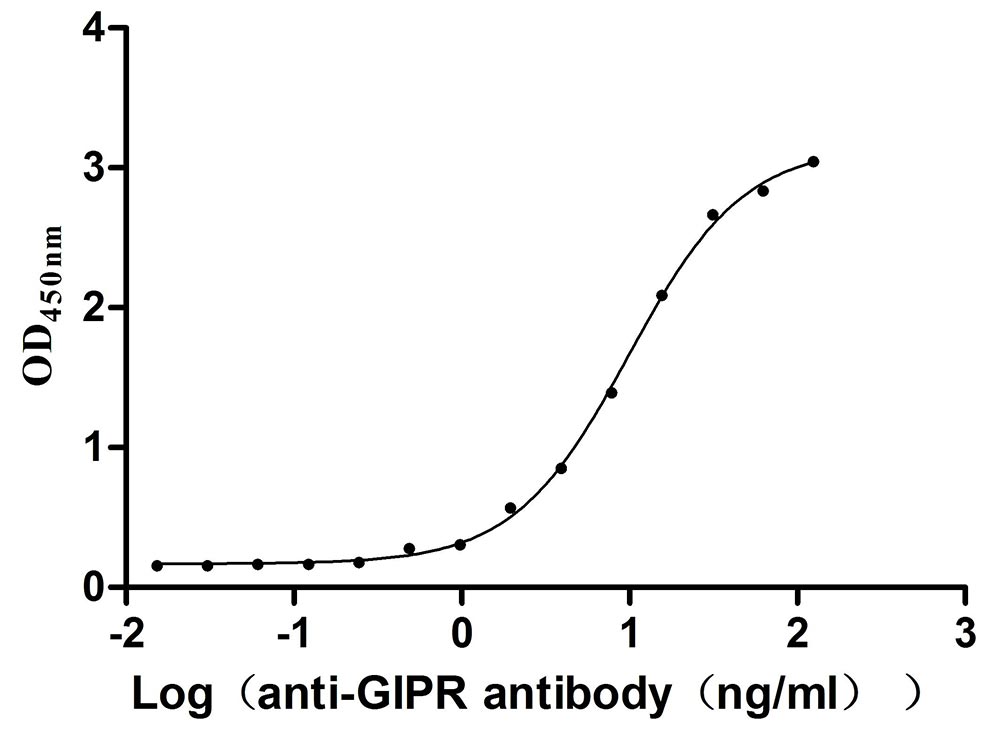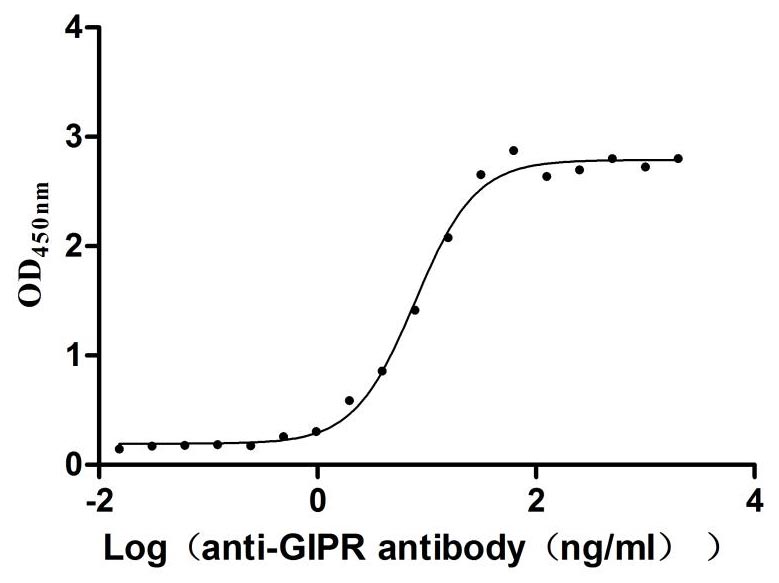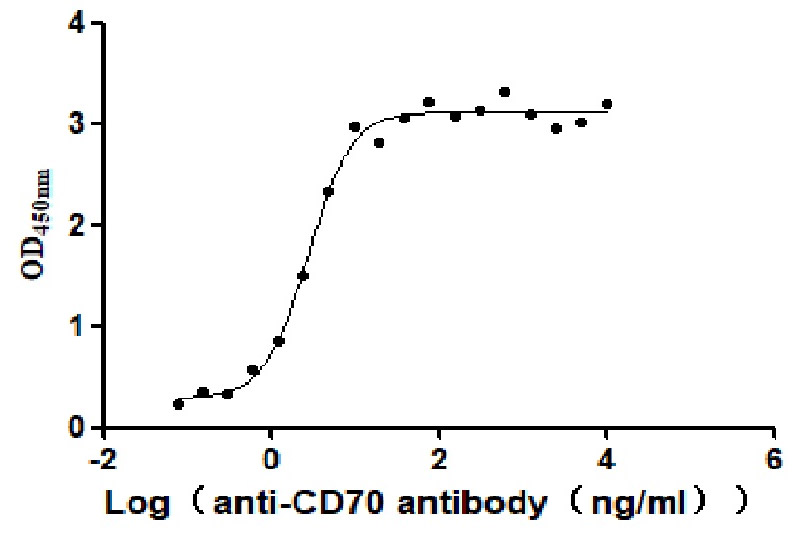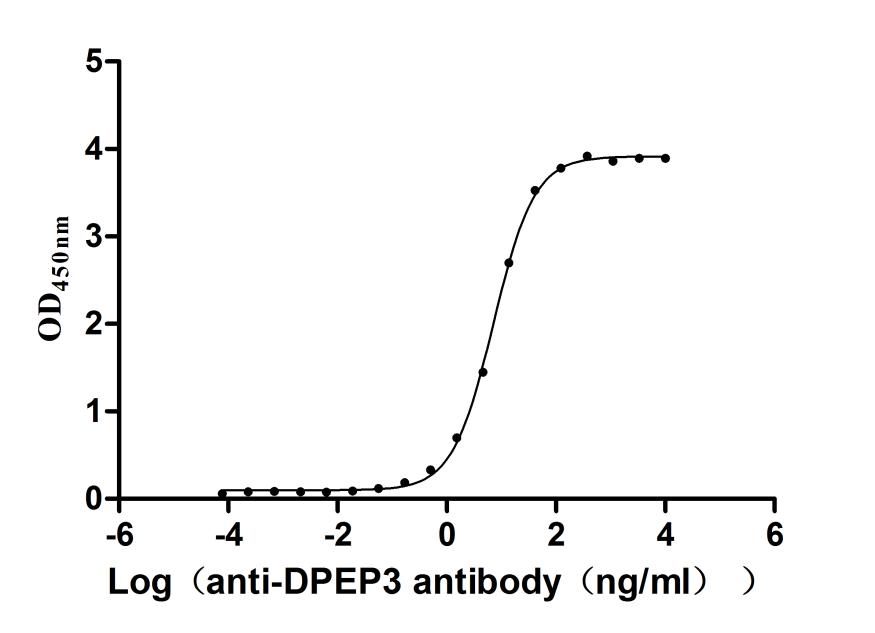Recombinant Rat Lysophosphatidic acid receptor 1 (Lpar1)
-
货号:CSB-CF013047RA
-
规格:
-
来源:in vitro E.coli expression system
-
其他:
产品详情
-
基因名:
-
Uniprot No.:
-
别名:Lpar1; Edg2; Gpcr91; Lpa1; Lysophosphatidic acid receptor 1; LPA receptor 1; LPA-1; Lysophosphatidic acid receptor Edg-2
-
种属:Rattus norvegicus (Rat)
-
蛋白长度:Full length protein
-
表达区域:1-364
-
氨基酸序列MAAASTSSPVISQPQFTAMNEQQCFYNESIAFFYNRSGKYLATEWNTVSKLVMGLGITVC VFIMLANLLVMVAIYVNRRFHFPIYYLMANLAAADFFAGLAYFYLMFNTGPNTRRLTVST WLLRQGLIDTSLTASVANLLAIAIERHITVFRMQLHTRMSNRRVVVVIVVIWTMAIVMGA IPSVGWNCICDIDHCSNMAPLYSDSYLVFWAIFNLVTFVVMVVLYAHIFGYVRQRTMRMS RHSSGPRRNRDTMMSLLKTVVIVLGAFIVCWTPGLVLLLLDVCCPQCDVLAYEKFFLLLA EFNSAMNPIIYSYRDKEMSATFRQILCCQRNENPNGPTEGSDRSASSLNHTILAGVHSND HSVV
Note: The complete sequence including tag sequence, target protein sequence and linker sequence could be provided upon request. -
蛋白标签:N-terminal 10xHis-tagged
-
产品提供形式:Liquid or Lyophilized powder
Note: We will preferentially ship the format that we have in stock, however, if you have any special requirement for the format, please remark your requirement when placing the order, we will prepare according to your demand. -
缓冲液:Lyophilized from Tris/PBS-based buffer, 6% Trehalose, pH 8.0
-
储存条件:Store at -20°C/-80°C upon receipt, aliquoting is necessary for mutiple use. Avoid repeated freeze-thaw cycles.
-
保质期:The shelf life is related to many factors, storage state, buffer ingredients, storage temperature and the stability of the protein itself.
Generally, the shelf life of liquid form is 6 months at -20°C/-80°C. The shelf life of lyophilized form is 12 months at -20°C/-80°C. -
货期:Basically, we can dispatch the products out in 1-3 working days after receiving your orders. Delivery time may differ from different purchasing way or location, please kindly consult your local distributors for specific delivery time.Note: All of our proteins are default shipped with normal blue ice packs, if you request to ship with dry ice, please communicate with us in advance and extra fees will be charged.
-
注意事项:Repeated freezing and thawing is not recommended. Store working aliquots at 4°C for up to one week.
-
Datasheet & COA:Please contact us to get it.
相关产品
靶点详情
-
功能:Receptor for lysophosphatidic acid (LPA). Plays a role in the reorganization of the actin cytoskeleton, cell migration, differentiation and proliferation, and thereby contributes to the responses to tissue damage and infectious agents. Activates downstream signaling cascades via the G(i)/G(o), G(12)/G(13), and G(q) families of heteromeric G proteins. Signaling inhibits adenylyl cyclase activity and decreases cellular cAMP levels. Signaling triggers an increase of cytoplasmic Ca(2+) levels. Activates RALA; this leads to the activation of phospholipase C (PLC) and the formation of inositol 1,4,5-trisphosphate. Signaling mediates activation of down-stream MAP kinases. Contributes to the regulation of cell shape. Promotes Rho-dependent reorganization of the actin cytoskeleton in neuronal cells and neurite retraction. Promotes the activation of Rho and the formation of actin stress fibers. Promotes formation of lamellipodia at the leading edge of migrating cells via activation of RAC1. Through its function as lysophosphatidic acid receptor, plays a role in chemotaxis and cell migration, including responses to injury and wounding. Plays a role in triggering inflammation in response to bacterial lipopolysaccharide (LPS) via its interaction with CD14. Promotes cell proliferation in response to lysophosphatidic acid. Required for normal skeleton development. May play a role in osteoblast differentiation. Required for normal brain development. Required for normal proliferation, survival and maturation of newly formed neurons in the adult dentate gyrus. Plays a role in pain perception and in the initiation of neuropathic pain.
-
基因功能参考文献:
- The data suggest that the LPAR1 mutants perturb lysophosphatidic acid signaling in cancer tissues. PMID: 28342860
- Results suggest LPA signaling via activation of LPA1 may be necessary for dopamine neuron development and survival PMID: 26169757
- These findings indicate lysophosphatidylethanolamine increases intracellular Ca(2+) via a LPA-1/Gi/o proteins/phospholipase C/IP3/Ca(2+) rise/Ca(2+) influx pathway in PC-12 neuronal cells. PMID: 25888792
- Conventional protein kinase C alpha and beta isozymes modulate LPA1 receptor phosphorylation state. PMID: 24355769
- The LILPA1 in dysplastic lesions and normal epithelium of Cd-treated rats was significantly higher. PMID: 23451264
- These results suggest that activation of LPA signaling via mutated LPA(1) may play an important role in the promotion of angiogenesis in rat neuroblastoma cells. PMID: 22580000
- The ability of LPA-LPA(1) signaling to promote epithelial cell apoptosis and fibroblast resistance to apoptosis may therefore contribute to the capacity of this signaling pathway to regulate the development of pulmonary fibrosis after lung injury. PMID: 22021336
- DNA methylation of the lpa1 gene may be involved in its reduced expression in rat tumor cells PMID: 16970915
- IL-1beta inhibits LPA-1 receptor-mediated Rho signaling in astrocytes through the IL-1 receptor, thereby disclosing the LPA-1 receptor-mediated Gi protein/RAC/migration pathway. PMID: 21244430
- These results strongly suggest that the LPA-LPA1 receptor signaling pathway plays a role in the induction of bone cancer-related pain PMID: 20553953
- Edg2 is expressed in mature oligodendrocytes, shortly before the onset of myelination. PMID: 12139919
- nuclear lysophosphatidic acid receptor (LPAR1) type-1 modulates pro-inflammatory gene expression. PMID: 12847111
- These results suggest that LPA receptor signaling may play an important role in neuroprotection in retinal ischemia-reperfusion injury. PMID: 17026968
- The results demonstrated that mutations in LPA1 gene occur in rat HCCs induced by DEN and the CDAA diet, suggesting that LPA1 mutations may be essentially involved in rat liver carcinogenesis. PMID: 19000703
- These results suggest that mutations of LPA1 gene may be involved in the acquisition of growth advantage from adenomas to adenocarcinomas in lung carcinogenesis induced in rats by N-nitrosobis(2-hydroxypropyl)amine . PMID: 19026987
显示更多
收起更多
-
亚细胞定位:Cell surface. Cell membrane; Multi-pass membrane protein. Endosome.
-
蛋白家族:G-protein coupled receptor 1 family
-
组织特异性:Detected in brain corpus callosum, medulla oblongata, cerebellum and sciatic nerve. Detected in heart.
-
数据库链接:
KEGG: rno:116744
STRING: 10116.ENSRNOP00000043652
UniGene: Rn.11200
Most popular with customers
-
Recombinant Human Leukemia inhibitory factor receptor (LIFR), partial (Active)
Express system: Mammalian cell
Species: Homo sapiens (Human)
-
Recombinant Human Interleukin-17A (IL17A) (T26A) (Active)
Express system: Baculovirus
Species: Homo sapiens (Human)
-
Recombinant Human Interleukin-2 receptor subunit alpha (IL2RA), partial (Active)
Express system: Mammalian cell
Species: Homo sapiens (Human)
-
Recombinant Mouse Gastric inhibitory polypeptide receptor (Gipr), partial (Active)
Express system: Mammalian cell
Species: Mus musculus (Mouse)
-
Recombinant Rat Gastric inhibitory polypeptide receptor (Gipr), partial (Active)
Express system: Mammalian cell
Species: Rattus norvegicus (Rat)
-
Recombinant Human Carcinoembryonic antigen-related cell adhesion molecule 8(CEACAM8) (Active)
Express system: Mammalian cell
Species: Homo sapiens (Human)
-
Recombinant Human CD70 antigen (CD70), partial (Active)
Express system: Mammalian cell
Species: Homo sapiens (Human)
-
Recombinant Human Dipeptidase 3(DPEP3), partial (Active)
Express system: Mammalian cell
Species: Homo sapiens (Human)


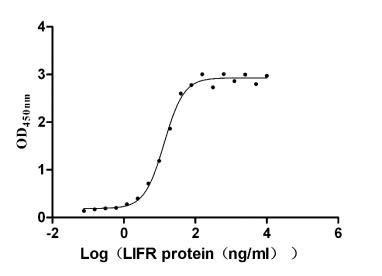
-AC1.jpg)
